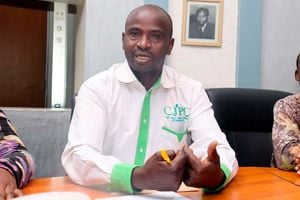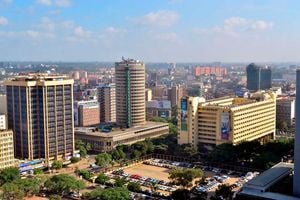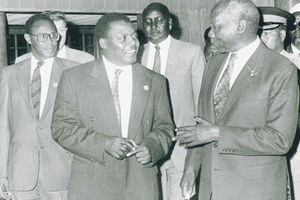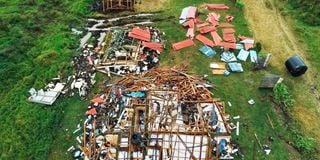
Demolished buildings on May 16, 2020, as the government began evicting hundreds of people who bought land next to the controversial 3,000-acre plot to pave the way for the expansion of the Dandora Sewage Treatment Plant in Ruai, Nairobi.
When Embakasi Ranching Company was asked to cede its land in Ruai to construct a new sewage treatment plant, it was after the colonial-era Kariobangi Treatment Plant could not cope with Nairobi’s expanding population.
Kariobangi had a capacity of 32,000 cubic metres of water per day, and the Nairobi planners knew it was only a matter of time before Nairobi City faced a crisis with raw sewage finding its way into the water system.
Planners had found that the lowest place where a sewerage plant would be built was within the privately-owned Embakasi Ranching Company, which was previously part of the expansive Juja Sisal Estate.
The Jomo Kenyatta government made a compulsory acquisition of 4,240 acres from Embakasi Ranching to provide Nairobi residents with land for the future expansion of sewage treatment facilities.
But this month, Interior minister Prof Kithure Kindiki degazetted 60 per cent of this land and effectively returned it to politically-connected “developers” who claim to have bought it.
Those who claim the land include Offshore Trading Company, associated with former Youth for Kanu ’92 chairman Cyrus Jirongo – who claims to be the rightful owner of 1,000 acres under L.R. No. 12979/3 – and Renton Company Limited, which claims to own approximately 1,606 acres under L.R.12979/4.
Also Read: Is this the woman with the riskiest job in Kenya? Theologian takes over Embakasi Ranching firm
When the Uhuru Kenyatta government reclaimed the land, there were allegations that Renton Company was linked to then Deputy President William Ruto (now President). His spokesman denied these allegations.
When the sewage plant was built, it was to cater for Nairobi’s then one million residents, and it was hoped that the balance of 2,600 acres, out of the 4,240 acres, would in the future cater for the city’s growing population for several decades. The choice of Ruai was informed by its terrain as area MCA, Silas Matara, reminded the County Assembly in June this year.
“When you look at the terrain of Nairobi, Ruai is the lowest side. So, even if it takes hundred years from today, it is important that that land is protected. Whoever has encroached should be put into question,” he said.
That appears to have been overtaken by events.
During the Moi presidency, according to knowledgeable sources, the Head of State had been convinced that Kibera residents could be settled on the land, and they vacate the prime land that they occupied. During this period, Jirongo, a powerful YK92 politico, was given 1,000 acres where he intended to build a “city”.
But Jirongo’s company charged the land as part security to help his other entity, Sololo Outlets, which was doing multibillion deals with the National Social Security Fund (NSSF), to acquire a Sh1 billion loan from Postbank, a playground of Kanu politicians. Offshore failed to pay this debt from Postbank, and the loan has ballooned to more than Sh20 billion. For several years, Jirongo has been fighting with the Central Bank of Kenya’s (CBK) Deposit Protection Fund Board (DPFB), which is seeking to sell the Ruai property to recover the debt. Jirongo was also fighting with squatters styled as Ruai Embakasi Youth United Development Organisation, who claimed to be the bona fide settlers on the land.
While that was happening, President Uhuru Kenyatta kicked out all the squatters and took over the land occupied by Renton Company and Jirongo. He declared the 4,000 acres a protected zone — meaning it was not available for squatters. Prof Kindiki has now reversed this order.
When it was built, the Dandora Estate Sewerage Treatment Plant, as it is officially known, was the largest wastewater stabilisation pond in Africa, and it was treating 80 per cent of all Nairobi’s wastewater. Initially, it had a capacity of processing 80,000 cubic metres of wastewater per day, which has not grown in tandem with the population.
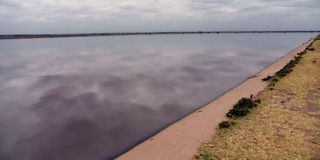
Ruai Sewage Treatment Plant in Nairobi.
Today, Nairobi discharges about 400,000 cubic metres of wastewater per day, of which only 192,000 cubic metres are treated by the two wastewater treatment plants in Ruai and Kariobangi. The rest flows into streams untreated. The loss of the land means that Nairobi residents will not have land to expand the sewerage infrastructure.
During the reign of Mayor Dick Waweru, squatters from Githunguri constituency were brought in after the Nairobi City Council “passed” minutes to excise 1,000 acres of the Ruai sewerage land. These were mainly Waweru’s supporters.
During this period, Mwangi Thuita, the chairman of Embakasi Ranching Company, formed the Ruai Original Squatters Association. There were perpetual running battles between the Githunguri and Mwangi Thuita’s group. Finally, some of the land was fenced by Renton.
In 1998, then Starehe MP Maina Kamanda told Parliament that a “piece of land set aside for sewage at Ruai is now being dished out by Nairobi City Council officers.”
He said, “Some of those officers are more powerful than the Minister for Local Authorities, and the minister cannot even touch them because they have their godfathers elsewhere in the system”.
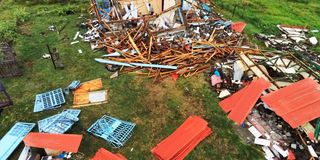
Demolished buildings on May 16, 2020, of people who bought land next to a controversial 3,000-acre plot to pave the way for the expansion of the Dandora Sewage Treatment Plant in Ruai, Nairobi.
The untouchables of that period were claimed to include Town Clerk Zipporah Wandera and the town planner Kuria wa Gathoni. The two were cited by Wycliffe Osundwa in 1999 in Parliament as the “most corrupt in the country.” Wandera and wa Gathoni’s reign was marked by wanton grabbing of public property in Nairobi.
“These two people should be investigated and brought to justice,” said Osundwa.
In 2000, Embakasi MP David Mwenje retook the matter to Parliament: “Is the minister aware that a Nairobi councillor has subdivided 1,000 acres of Ruai sewerage land without the authority of Nairobi Plot Allocation Committee?”
Also Read:Inside Kenya’s land buying con games
Interestingly, Mwenje was also allocating his supporters land within the privately-owned Kiambu Dandora Farm.
By then, the entire Ruai and Embakasi had become a free-for-all as political and private interests found space to buy power. Squatters occupied private land, including Kamau Kirima’s Njiru land, while Embakasi Ranch was also turned into a playground for various land dealers and politicians. The unfenced Ruai wastewater land was not spared.
Last year, then Water and Sanitation Cabinet Secretary Sicily Kariuki, while visiting Dandora Estate Wastewater Treatment Plant, announced that Sh1.3 billion to build an additional seven ponds was underway to treat an additional 20 million litres of wastewater per day.
To secure the land, a 13km masonry boundary wall was to be built around the treatment plant. The expansion would have increased the treatment capacity from the existing 160 million litres per day to 180 million litres per day.
During an inspection of the project, Ms Kariuki said, “I am pleased with the progress of the works, which are now at about 30 per cent completion. We have since reclaimed 4,250 acres of the land which had been encroached by private developers, availing more land for the expansion.”
That has now been lost again.
Nairobi’s backlog of sewage development has been perennial. In 1980, the government admitted it was facing a ten-year backlog of sewage in Nairobi and wanted to upgrade the Kariabangi sewage.
They had then advised those downstream and relying on the Athi River to “boil the water before drinking.” But ever since, the city has been unable to cope with the pace of population growth.
On its website, Nairobi Water Company still claims that the Dandora Estate Sewerage Treatment Works occupies 4,000 acres. On the ground, things are different.
Renton Company has also been fighting to silence those opposed to its takeover of the land. In 2010, it took the then Nairobi Town Clerk Philip Kisia and the City Council of Nairobi to court, saying it was suffering a “loss of reputation” for being described as a land grabber.
It claimed to be the rightful proprietor of L.R. No. 12979/4 and claimed to have paid Sh18.2 million to the Nairobi City Council. Mr James Gitundu signed the affidavit as the director of Renton.
Recently, Renton was found to have illegally acquired another piece of land in the same neighbourhood. The Supreme Court ruled in September that Renton could not purport to sell land allocated to it illegally by the Nairobi City Council.
As the two parcels of land revert to the private companies, it will be interesting to see how the courts will handle the cases if the matter heads there.
In previous rulings, the Land court held that public land cannot be allocated to a third party after compulsory acquisition. It will be interesting to see whether the Ruai land will end up in the sewers.
[email protected]; @johnkamau1

